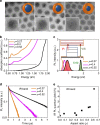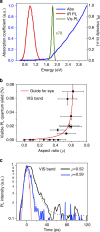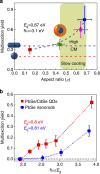Enhanced carrier multiplication in engineered quasi-type-II quantum dots
- PMID: 24938462
- PMCID: PMC4083434
- DOI: 10.1038/ncomms5148
Enhanced carrier multiplication in engineered quasi-type-II quantum dots
Abstract
One process limiting the performance of solar cells is rapid cooling (thermalization) of hot carriers generated by higher-energy solar photons. In principle, the thermalization losses can be reduced by converting the kinetic energy of energetic carriers into additional electron-hole pairs via carrier multiplication (CM). While being inefficient in bulk semiconductors this process is enhanced in quantum dots, although not sufficiently high to considerably boost the power output of practical devices. Here we demonstrate that thick-shell PbSe/CdSe nanostructures can show almost a fourfold increase in the CM yield over conventional PbSe quantum dots, accompanied by a considerable reduction of the CM threshold. These structures enhance a valence-band CM channel due to effective capture of energetic holes into long-lived shell-localized states. The attainment of the regime of slowed cooling responsible for CM enhancement is indicated by the development of shell-related emission in the visible observed simultaneously with infrared emission from the core.
Figures






Similar articles
-
PbSe-Based Colloidal Core/Shell Heterostructures for Optoelectronic Applications.Materials (Basel). 2014 Oct 30;7(11):7243-7275. doi: 10.3390/ma7117243. Materials (Basel). 2014. PMID: 28788244 Free PMC article. Review.
-
Generating free charges by carrier multiplication in quantum dots for highly efficient photovoltaics.Acc Chem Res. 2015 Feb 17;48(2):174-81. doi: 10.1021/ar500248g. Epub 2015 Jan 21. Acc Chem Res. 2015. PMID: 25607377
-
Spin-exchange carrier multiplication in manganese-doped colloidal quantum dots.Nat Mater. 2023 Aug;22(8):1013-1021. doi: 10.1038/s41563-023-01598-x. Epub 2023 Jul 13. Nat Mater. 2023. PMID: 37443379 Free PMC article.
-
Design and synthesis of heterostructured quantum dots with dual emission in the visible and infrared.ACS Nano. 2015 Jan 27;9(1):539-47. doi: 10.1021/nn505793y. Epub 2014 Dec 18. ACS Nano. 2015. PMID: 25427007
-
Broadband Cooling Spectra of Hot Electrons and Holes in PbSe Quantum Dots.ACS Nano. 2017 Jun 27;11(6):6286-6294. doi: 10.1021/acsnano.7b02506. Epub 2017 Jun 6. ACS Nano. 2017. PMID: 28558190 Free PMC article.
Cited by
-
Epitaxial CdSe/PbSe Heterojunction Growth and MWIR Photovoltaic Detector.Materials (Basel). 2023 Feb 24;16(5):1866. doi: 10.3390/ma16051866. Materials (Basel). 2023. PMID: 36902982 Free PMC article.
-
Excited-State Dynamics in Colloidal Semiconductor Nanocrystals.Top Curr Chem (Cham). 2016 Oct;374(5):58. doi: 10.1007/s41061-016-0060-0. Epub 2016 Aug 9. Top Curr Chem (Cham). 2016. PMID: 27573500 Free PMC article. Review.
-
Efficient Carrier Multiplication in Low Band Gap Mixed Sn/Pb Halide Perovskites.J Phys Chem Lett. 2020 Aug 6;11(15):6146-6149. doi: 10.1021/acs.jpclett.0c01788. Epub 2020 Jul 20. J Phys Chem Lett. 2020. PMID: 32672041 Free PMC article.
-
PbSe-Based Colloidal Core/Shell Heterostructures for Optoelectronic Applications.Materials (Basel). 2014 Oct 30;7(11):7243-7275. doi: 10.3390/ma7117243. Materials (Basel). 2014. PMID: 28788244 Free PMC article. Review.
-
Carrier multiplication in van der Waals layered transition metal dichalcogenides.Nat Commun. 2019 Dec 2;10(1):5488. doi: 10.1038/s41467-019-13325-9. Nat Commun. 2019. PMID: 31792222 Free PMC article.
References
-
- Shockley W. & Queisser H. J. Detailed balance limit of efficiency of p-n junction solar cells. J. Appl. Phys. 32, 510–519 (1961).
-
- Wang X. et al. Tandem colloidal quantum dot solar cells employing a graded recombination layer. Nat. Photon. 5, 480–484 (2011).
-
- Dou L. et al. Tandem polymer solar cells featuring a spectrally matched low-bandgap polymer. Nat. Photon. 6, 180–185 (2012).
-
- Luque A. & Martí A. Increasing the efficiency of ideal solar cells by photon induced transitions at intermediate levels. Phys. Rev. Lett. 78, 5014–5017 (1997).
-
- Luque A., Marti A. & Stanley C. Understanding intermediate-band solar cells. Nat. Photon. 6, 146–152 (2012).
Publication types
LinkOut - more resources
Full Text Sources
Other Literature Sources

